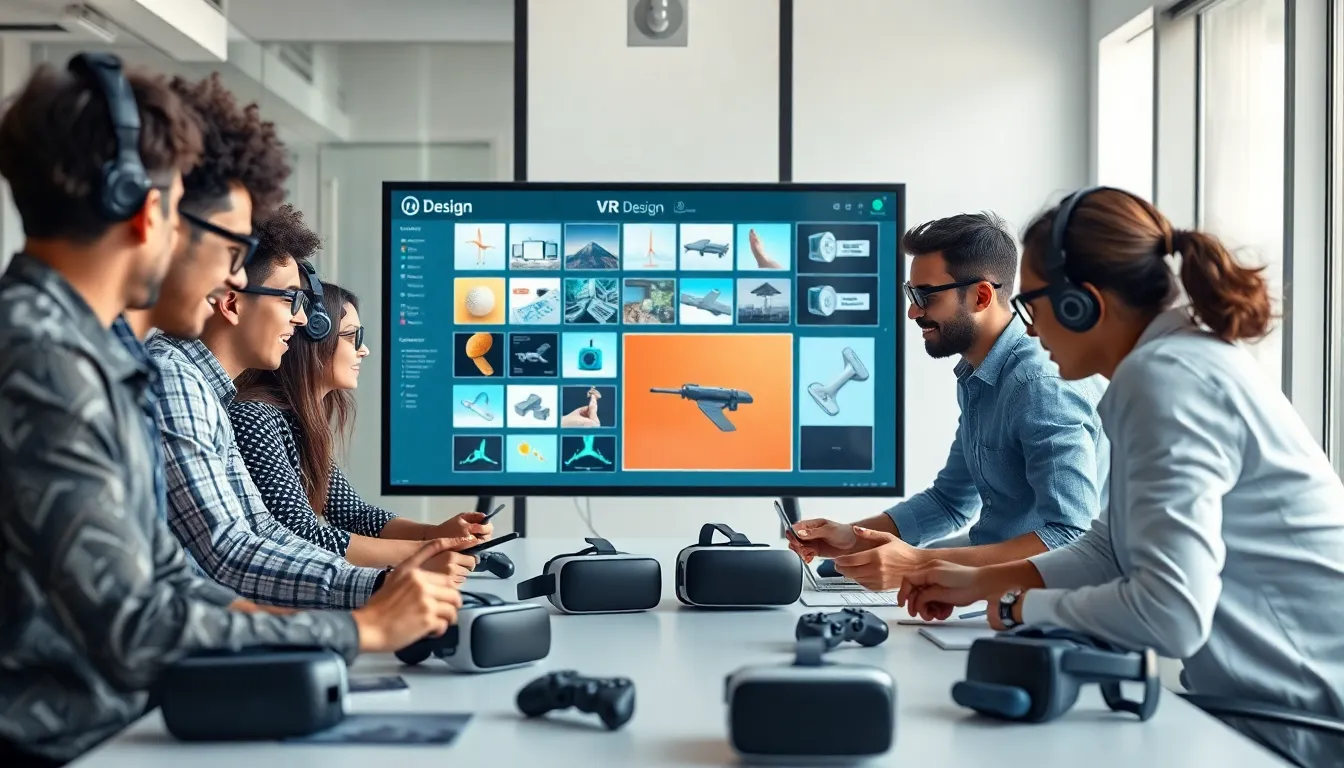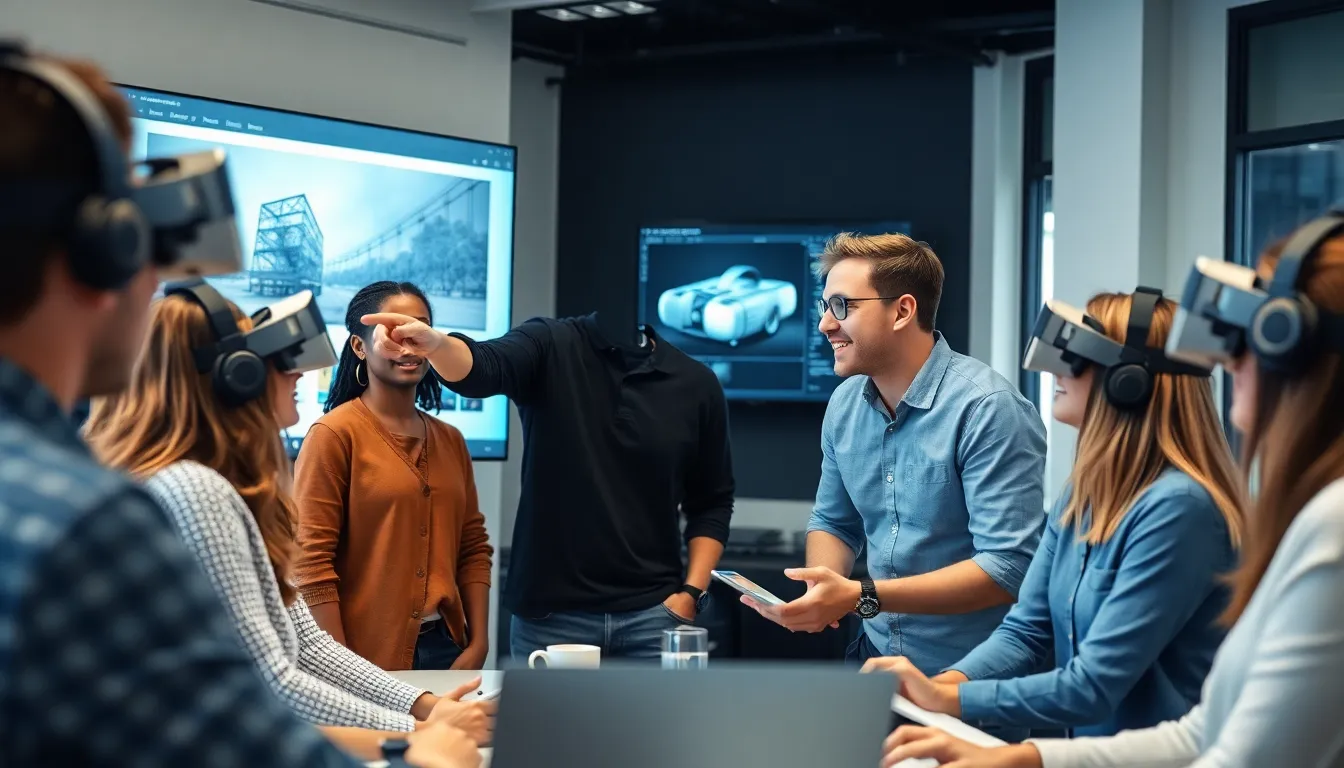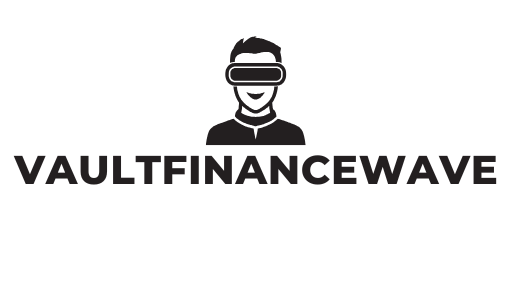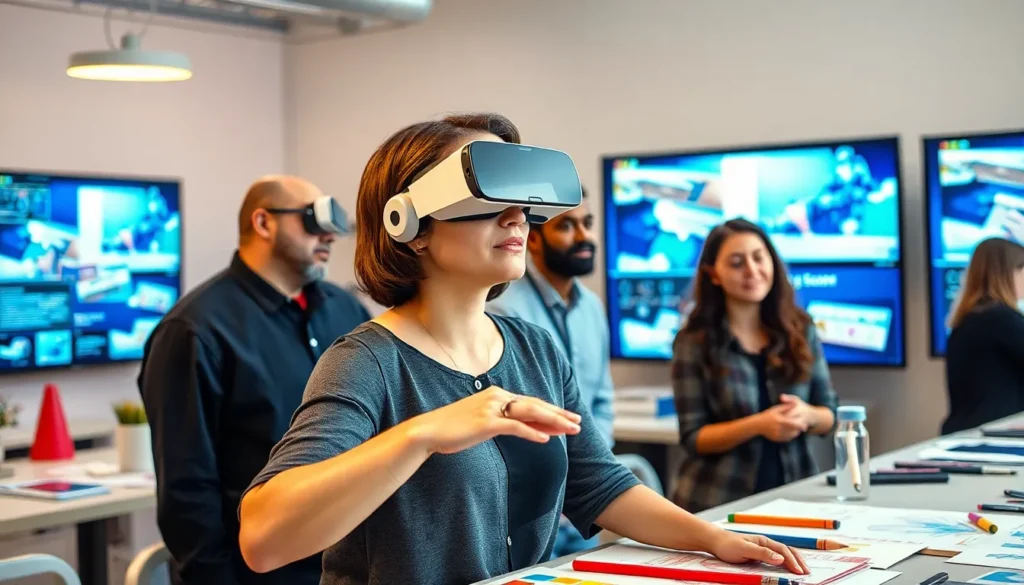Table of Contents
ToggleVirtual reality is transforming the way designers create immersive experiences. With the rise of VR design software, professionals can now bring their visions to life in ways that were once unimaginable. This cutting-edge technology allows users to craft detailed environments and interactive elements that engage audiences on a whole new level.
As industries from gaming to architecture embrace VR, understanding the best design tools becomes essential. The right software not only enhances creativity but also streamlines the design process, making it easier to visualize concepts and collaborate with teams. In this article, we’ll explore the top VR design software options available today, highlighting their unique features and benefits for creators looking to push the boundaries of their craft.
Overview of VR Design Software
VR design software enables creators to develop immersive virtual environments and experiences. These tools streamline the design process, enhance collaboration, and stimulate innovation. Various software options cater to different design needs, including architecture, gaming, education, and healthcare.
Key Features
- Real-time rendering: VR design software allows for real-time visualization of changes, enabling instant feedback and adjustments.
- User-friendly interfaces: Many platforms provide intuitive interfaces, simplifying navigation for both beginners and experienced designers.
- Collaboration tools: Software often includes features that facilitate teamwork, allowing multiple users to interact within the same virtual space simultaneously.
Leading VR Design Software
| Software Name | Primary Features | Ideal Users |
|---|---|---|
| Unity | Real-time rendering, extensive asset store | Game developers, animators |
| Unreal Engine | High-fidelity graphics, blueprint scripting | Architects, artists |
| Blender | Open-source, versatile modeling tools | 3D artists, animators |
| SketchUp | Easy modeling, integration with VR plugins | Architects, designers |
| Tilt Brush | Freehand painting in 3D space | Artists, hobbyists |
These software solutions provide powerful capabilities for creating stunning virtual experiences. Selecting the right VR design software significantly impacts project outcomes, stimulating creativity and improving workflow efficiency.
Key Features to Consider


Selecting VR design software hinges on several crucial features that enhance usability and workflow. These features significantly affect the effectiveness of the design process and the overall user experience.
User Interface and Usability
User interface (UI) and usability play critical roles in the effectiveness of VR design software. A well-designed UI simplifies navigation, enabling users to access tools easily. Intuitive interfaces reduce the learning curve for new users, promoting faster adoption. Software like Unity and Blender boasts user-friendly environments that enhance productivity. Features such as customizable toolbars and drag-and-drop functionality further streamline the design process, allowing creators to focus on innovation instead of getting bogged down by complex operations.
Compatibility and Integration
Compatibility and integration serve as essential factors when evaluating VR design software. Compatibility with various hardware, such as VR headsets and motion controllers, ensures seamless operation across devices. Software that supports popular platforms enables broader application development. Integration with collaboration tools and existing design workflows enhances efficiency and fosters teamwork. For instance, Unity and Unreal Engine provide robust APIs, facilitating connections with third-party applications. This capability helps designers create cohesive projects without friction or disruptions.
Popular VR Design Software Options
Numerous VR design software options exist, each catering to different needs and industries. Below are three leading choices, along with their key features that enhance the design experience.
Software A: Unity Overview and Features
Unity serves as a powerful game engine widely used for VR design. It boasts real-time rendering, which provides instant feedback during the design process. Its user-friendly interface simplifies navigation, making it accessible to beginners and advanced users alike. Unity supports multiple platforms, allowing designers to create VR experiences for Oculus Rift, HTC Vive, and other devices. Collaboration tools enable teams to work together seamlessly in a shared virtual environment, enhancing productivity.
Software B: Unreal Engine Overview and Features
Unreal Engine, known for its high-fidelity graphics, excels in creating immersive environments. Its Blueprint visual scripting system allows designers to develop complex functionalities without extensive programming knowledge. The software offers advanced lighting and rendering features, producing stunning visuals crucial for architectural visualization and gaming. Unreal Engine’s marketplace provides a wide array of resources, including assets and plugins to extend functionality, making it a versatile choice for professionals.
Software C: Blender Overview and Features
Blender stands out as a free and open-source software renowned for 3D modeling and animation. It offers a comprehensive set of tools for VR content creation, including sculpting, texturing, and rigging. Blender’s integration with various VR headsets allows designers to view their creations in real-time, enhancing the design and review process. Its active community contributes a plethora of tutorials and resources, fostering rapid skill development among users. Additionally, Blender supports add-ons that enhance workflow and functionality, making it an excellent option for budget-conscious designers.
Advantages of Using VR Design Software
VR design software offers numerous advantages that significantly enhance the creative process and design outcomes.
- Immersive Experiences: VR design software enables users to create fully immersive environments. These environments allow stakeholders to experience designs in a realistic setting, fostering better understanding and engagement.
- Real-Time Feedback: Real-time rendering in VR design software provides instant visual feedback on design elements. This capability allows designers to make immediate adjustments, streamlining the design process and improving efficiency.
- Enhanced Collaboration: Collaboration tools within VR design software support teamwork by allowing multiple users to interact in the same virtual space. This feature ensures better communication and decision-making among team members, regardless of their physical location.
- Cost Efficiency: VR design software can reduce costs associated with physical prototypes or traditional mock-ups. By visualizing designs virtually, creators can identify issues early in the development stage, minimizing costly revisions later.
- User-Friendly Interfaces: Many VR design platforms prioritize user experience, featuring intuitive interfaces that simplify navigation. This ease of use accelerates learning curves for new users, enhancing productivity.
- Versatility Across Sectors: VR design software finds applications in various industries, including architecture, gaming, education, and healthcare. This adaptability allows professionals from different fields to leverage VR for unique design challenges.
- Cutting-Edge Tools and Features: Advanced tools like procedural modeling, lighting adjustments, and animation within VR design software enhance the creative possibilities for designers. These tools empower users to experiment and push the boundaries of their designs.
- Accessibility of Resources: Many VR design platforms come with extensive libraries of pre-built assets and community support. Access to these resources expedites the design process, enabling creators to focus on innovation.
Emphasizing these advantages highlights the transformative potential of VR design software in revolutionizing design workflows and enhancing overall project outcomes.
Best Practices for Effective VR Design
Creating successful VR experiences requires adherence to several best practices:
- User-Centered Design
Prioritize the user’s needs and experiences during the design process. Gather user feedback through testing to identify pain points and enhance usability.
- Intuitive Navigation
Develop intuitive controls that facilitate seamless interaction within the VR environment. Use familiar gestures and patterns to reduce the learning curve for new users.
- Realism in Graphics
Focus on high-quality graphics and realistic textures to create immersive environments. Utilize advanced rendering techniques in tools like Unreal Engine to enhance visual fidelity.
- Spatial Awareness
Design spaces that consider the user’s physical movements. Keep in mind the dimensions of VR environments to prevent discomfort and ensure safe navigation.
- Sound Design
Integrate immersive audio elements that correspond with visual cues. Surround sound can significantly enhance the user experience and create a more engaging atmosphere.
- Optimized Performance
Optimize assets to ensure smooth performance across various hardware. Consider frame rates and loading times to maintain a fluid experience and minimize motion sickness.
- Accessibility Features
Incorporate accessibility options to cater to diverse users. Features such as adjustable controls and visual aids can enhance inclusivity in VR designs.
- Iterative Testing
Conduct iterative testing throughout the design process. Regularly revisiting and refining designs based on feedback guarantees improvements and a more polished final product.
By following these best practices, VR designers can create impactful experiences that resonate with users, enhancing both creativity and functionality in their design projects.
The evolution of VR design software is reshaping how creators approach immersive experiences. By leveraging advanced tools, designers can enhance collaboration and streamline workflows while pushing creative boundaries. The selection of the right software is vital for maximizing efficiency and innovation within various industries.
As VR technology continues to advance, staying informed about the latest software options and best practices will empower designers to craft engaging and impactful virtual environments. Embracing these tools not only fosters creativity but also transforms the way design projects are executed, ultimately leading to more successful outcomes.




